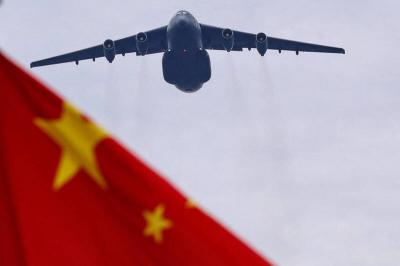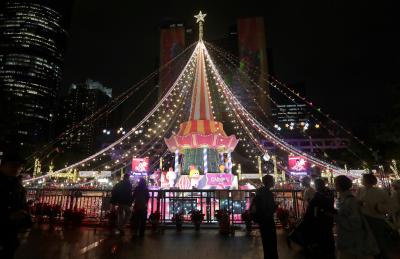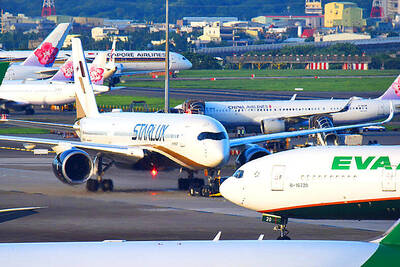In a move that could strengthen Taiwan’s security, the US is moving two high-altitude “Global Hawk” spy drones to Japan to monitor the Chinese navy.
The unmanned drones — which can reach altitudes of 18km and stay airborne for 32 hours at a time — are to start operating from Misawa Air Base before the end of this month.
Their mission is to watch Chinese navy activities in the East China and South China seas, and through the Taiwan Strait.
They are also to gather intelligence about North Korea.
The transfer of the drones from Guam was first reported last week by online newspaper the Washington Free Beacon and confirmed by the US Air Force (USAF).
A USAF spokesperson said the drones are to be in Japan for four months and would support US “intelligence, surveillance and reconnaissance priorities.”
In addition, the spokesperson said the drones would “ensure continued regional stability and security to all nations in the Asia-Pacific [region].”
While the Pentagon remains silent about most military cooperation with Taiwan, Washington is likely to share any relevant intelligence with Taipei.
The Global Hawks are being moved to Japan while China has about 80 ships protecting an oil rig in waters claimed by Taiwan and Vietnam and as tensions with Japan continue to escalate over the Senkakus, known as the Diaoyutai Islands (釣魚台) in Taiwan.
News of the drone move also came as People’s Liberation Army Chief of General Staff General Fang Fenghui (房峰輝) ended a five-day visit to the US in which he said the US’ shift to the Pacific had “stirred up some of the problems” in the South China and East China seas.
“We do not create trouble, but we are not afraid of trouble,” he said.
“We will respond to threats,” US Joint Chiefs of Staff Chairman General Martin Dempsey said.
Writing in the Washington Post, senior fellows at the Council on Foreign Relations Elizabeth Economy and Michael Levi said this week that Chinese leaders were motivated in part by a desire to control the South China Sea lanes through which oil imports to Taiwan, China, Japan and South Korea pass.
“China’s latest move, which came as a surprise to Vietnam and other nations, undermines Bejing’s insistence that strong relations within the region are its top foreign policy priority,” Economy and Levi said.
“The US ought to call China’s bluff and make clear the real stakes,” they added.
The two policy analysts said the US and ASEAN should present a unified front in refusing to recognize unilateral assertions of claims in disputed territories.
US President Barack Obama’s rebalancing to Asia is premised on the US’ role as the primary guarantor of stability in the Pacific, Economy and Levi said.
Vietnam has reiterated its commitment to the peaceful resolution of the current dispute, the analysts said. If China does not reciprocate, the US should be prepared to support Vietnam through an increased naval presence, they added.
“This would give Washington the ability to assess Chinese capabilities and to help de-escalate the situation,” Economy and Levi said, adding that “if the US can’t back up its words with actions, its credibility in promising to uphold peace and stability in the region will be gutted.”

Beijing could eventually see a full amphibious invasion of Taiwan as the only "prudent" way to bring about unification, the US Department of Defense said in a newly released annual report to Congress. The Pentagon's "Annual Report to Congress: Military and Security Developments Involving the People's Republic of China 2025," was in many ways similar to last year’s report but reorganized the analysis of the options China has to take over Taiwan. Generally, according to the report, Chinese leaders view the People's Liberation Army's (PLA) capabilities for a Taiwan campaign as improving, but they remain uncertain about its readiness to successfully seize

Taiwan is getting a day off on Christmas for the first time in 25 years. The change comes after opposition parties passed a law earlier this year to add or restore five public holidays, including Constitution Day, which falls on today, Dec. 25. The day marks the 1947 adoption of the constitution of the Republic of China, as the government in Taipei is formally known. Back then the Chinese Nationalist Party (KMT) governed China from Nanjing. When the KMT, now an opposition party in Taiwan, passed the legislation on holidays, it said that they would help “commemorate the history of national development.” That

Trips for more than 100,000 international and domestic air travelers could be disrupted as China launches a military exercise around Taiwan today, Taiwan’s Civil Aviation Administration (CAA) said yesterday. The exercise could affect nearly 900 flights scheduled to enter the Taipei Flight Information Region (FIR) during the exercise window, it added. A notice issued by the Chinese Civil Aviation Administration showed there would be seven temporary zones around the Taiwan Strait which would be used for live-fire exercises, lasting from 8am to 6pm today. All aircraft are prohibited from entering during exercise, it says. Taipei FIR has 14 international air routes and

The Ministry of National Defense (MND) today released images of the military tracking China’s People's Liberation Army (PLA) movements during the latest round of Chinese drills around Taiwan. The PLA began "Justice Mission 2025" drills today, carrying out live-fire drills, simulated strikes on land and maritime targets, and exercises to blockade the nation's main ports. The exercises are to continue tomorrow, with the PLA announcing sea and air space restrictions for five zones around Taiwan for 10 hours starting from 8:30am. The ministry today released images showing a Chinese J-16 fighter jet tracked by a F-16V Block 20 jet and the